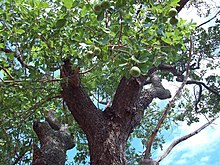Caryocaraceae
| Caryocaraceae | ||||||||||||
|---|---|---|---|---|---|---|---|---|---|---|---|---|

|
||||||||||||
| Systematics | ||||||||||||
|
||||||||||||
| Scientific name | ||||||||||||
| Caryocaraceae | ||||||||||||
| Voigt | ||||||||||||
| Genera | ||||||||||||
The Caryocaraceae are a family in the order of the Malpighiales (Malpighiales) within the flowering plants (Magnoliopsida).
Description and ecology

Vegetative characteristics
All species are evergreen , woody plants, mostly trees , rarely shrubs . They are all made of hard wood . There is a superficial cork cambium . The secondary growth in thickness is based on a conventional cambium ring . The leaves are seldom spiral, sometimes alternate ( Anthodiscus ), mostly opposite ( Caryocar ) on the branch. The leaves are divided into a petiole and a leaf blade. The leathery leaf blades are usually three-part, sometimes five-part. The pinnate leaflets rarely have an almost smooth, usually a serrated or toothed edge. There are (mostly) stipules present.
Generative characteristics
The flowers are usually too many together in racemose inflorescences . There are no bracts . In the large, radial symmetry flowers are hermaphroditic and most often five, sechszählig double perianth (perianth). The five or six sepals are fused at their base. The five or six petals are fused highest at their base. The flowers contain 50 to 200 particularly long stamens that develop centrifugally and are not fused with the petals. In some species the innermost stamens are reduced to staminodes . The pollen grains usually have three (two to six) apertures and are colporat or rugat. Four to twenty carpels are fused into a syncarpic, upper, four to twenty chambered ovary , with only one orthotropic to anatropic, bitegmic ovule per ovary crest. There are four to twenty free pens available. The species of the genus Caryocar are pollinated by bats (Chiroptera) ( Chiropterophilia ).

Mostly fleshy stone fruits or leathery split fruits are formed. The mesocarp is sometimes poisonous or sometimes edible. The seeds are kidney-shaped. The embryo is well developed. The spirally twisted hypocotyl contains oil and protein.
The basic chromosome number is x = 23.
Systematic distribution
The family name Caryocaraceae was first published in 1845 by Joachim Otto Voigt in Hortus Suburbanus Calcuttensis , 88. The publication of Caryocaraceae by Ignaz von Szyszylowicz in Engler and Prantl: Nat. Plant family 3, 6, p. 153 is not until 1893. Type genus is Caryocar L. Synonyms for Caryocaraceae Voigt are Rhizobolaceae DC. and Simabaceae Horan.
The species have their areas only in the Neotropic . Most of the species grow in the Amazon .
In the family of the Caryocaraceae there are only two genera with up to 30 species:
-
Anthodiscus G.Mey. The 8 to 15 species are distributed from Colombia to Venezuela to the Guyana states and in the northern and western Amazon basins :
- Anthodiscus amazonicus Gleason & ACSm. : It iswidespreadfrom southeastern Colombia via Ecuador to northern Brazil .
- Anthodiscus chocoensis Prance : It occurs in Colombia.
- Anthodiscus fragrans Sleumer : Home is Ecuador.
- Anthodiscus klugii Standl. ex Prance : It occurs in Ecuador and northern Peru.
- Anthodiscus mazarunensis Gilly : It is distributed from southern Venezuela to Surinam and Guiana.
- Anthodiscus montanus Gleason : The home is central Colombia.
- Anthodiscus obovatus Benth. ex Wittm. : It is widespread from Colombia through Venezuela to northern Brazil.
- Anthodiscus peruanus Baill. : It occurs in Ecuador and northern Peru.
- Anthodiscus pilosus Ducke : It occurs in southeastern Colombia and northern Peru.
- Anthodiscus trifoliatus G.Mey. : The homeland is Guiana .
- Caryocar F. Allam. ex L. (Syn .: Pekea Aubl. , Rhizobolus Gaertn. ex Schreb. , Saouari Aubl. ) The approximately 15 species are distributed from Costa Rica via Panama to southern Brazil and Paraguay .

Usage and ingredients
The fruits or seeds of about eight species of the genus Caryocar are used for eating (only cooked) or for oil production. The hard wood from Caryocar species is valued for building boats, for example.
The fruits of species of both genera are used as fish poison in catching.
They contain triterpenes - saponins - as important ingredients .
swell
- The family of caryocaraceae in APWebsite. (Section description)
- The Caryocaraceae family at DELTA by L. Watson & MJ Dallwitz. (Section description)
Individual evidence
- ^ A b c Robert E. Woodson, Robert W. Schery, Ghillean T. Prance: Flora of Panama. Part VI. Family 120. Caryocaraceae. In: Annals of the Missouri Botanical Garden , Vol. 63, No. 3, 1976, pp. 541-546.
- ↑ Caryocaraceae in the Germplasm Resources Information Network (GRIN), USDA , ARS , National Genetic Resources Program. National Germplasm Resources Laboratory, Beltsville, Maryland.
- ↑ a b c d e f g h i j k Rafaël Govaerts (Ed.): Caryocaraceae. In: World Checklist of Selected Plant Families (WCSP) - The Board of Trustees of the Royal Botanic Gardens, Kew . Retrieved May 14, 2017.

